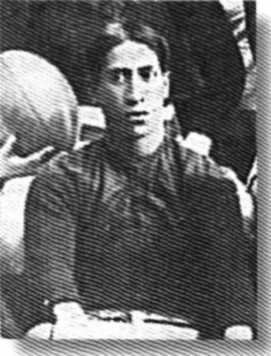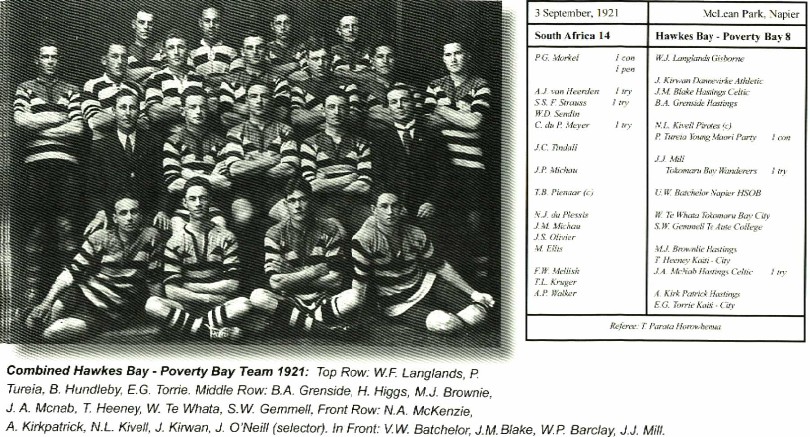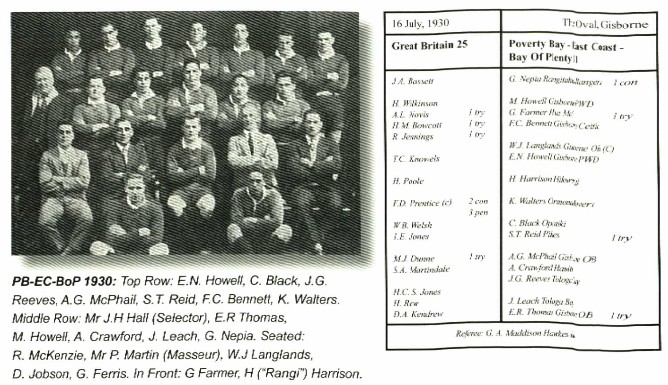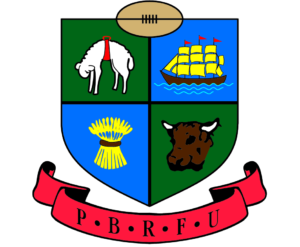The Early 1900’S
It was a red-letter day for the small population of the isolated district when the arrival of the steamship Tahura, in the early hours of a July 1908 Saturday morning, brought the Anglo-Welsh XV, the first overseas team to visit Poverty Bay.
Since 1901 player membership of clubs had been decided by their residence within boundaries of the district so that by 1908, there were only 3 clubs contesting the local championship. Kaiti-City derived its players from Cobden Street Eastwards through Kaiti to the Coast; West End members came from Cobden Street to Lytton Road while those from areas West of Lytton Road, including the country areas Waimata, Muriwai and Patutahi, played for Takitimu. Since its formation In 1903. players from the Waiapu sub-union, later to evolve into the East Coast Rugby Union in 1922, had been eligible to play for Poverty Bay. The home team selected to meet the tourists was composed of 8 from the champion West End club, 4 from Kaiti-City, 2 from Takitimu and one from Tolaga Bay
On game day, spectators crammed every vantage point, including the trees of the, then, main rugby ground, the Victoria Domain (now the site of the netball courts and the grounds of Gisborne Intermediate School) to view a game which, in retrospect, set a pattern for future games against visiting international sides. The superior speed of the British three-quarters had them scoring 4 of 7 tries but the inexperienced locals did better than the 26-0 score might suggest. A number of their promising attacks foundered through nervousness and mishandling but their “tigerish” tackling earned plaudits from the crowd.
- Autini Pitara Kaipara
In this game, ever-dangerous on attack when given the opportunity and for some years after, the star Poverty Bay player was midfield back, Autini Kaipara.
Autini Pitara Kaipara
Autini Kaipara was one of New Zealand rugby’s most outstanding second five-eighths of the decade leading up to World War One He represented Poverty Bay from 1906 until 1913, was captain of the side from 1910, leading two Ranfurly Shield challenges against Auckland He became Poverty Bay’s second player to be selected for the North Island, initially in 1910 and again in 1911 and 1912. He represented New Zealand Maori in 1910 and 1911, was a member of the North Island Country team that toured the South Island in 1912 and also played for the North Island B team in 1914.
Locals regarded him as a rugby wizard with his elusive sidestep and “turning run” on attack. He was described by the media of the time as the “India rubber man” and, on the 1910 Maori tour of Australia, the Sydney Morning Herald referred to him “as slippery as an eel.” He was still being written about decades after his death.
Autini Kaipara was a law clerk and was also registered as an interpreter under the Native Land Act. He was a member of a number of clubs Kaiti City 1906, Takitimu 1907, West End 1908 but in 1910 and the years immediately prior to the War, he played for the newly formed Young Maori Party Club. During the First World War he was promoted to second lieutenant in the Maori (Pioneer) Battalion. He was killed in action at the age of 30 on August 4, 1917.
The Challenge Of Travel In The Early Days
Because of the surrounding ranges, the early geographical isolation of the Poverty Bay flats meant that the port monopolized the transport of people in and out of Gisborne until the 1920s. Up to then, horseback was the main transport mode as “roads” to Napier and Opotiki were mere tracks which bogged down in winter and were beyond the capabilities of pre-First World War vehicles.
While the sea was the major means access and exit for most of the year, even then getting in and out of the Gisborne port was a “gamble.” Because larger vessels prevented from using the inner harbour, passengers were trans-shipped by tender out to the roadstead. Those leaving the District had to journey out to Arahura via the Union Company’s SS Tuatea. Where possible, companionways were used but, often in rough seas, travelers had to be carried aboard in large wicker baskets.
The 1920s saw better roads, more powerful vehicles and cars became more common in Gisborne and a “service car” schedule to Napier was set up. Although there must have been an improvement in travel comfort, by modern day standards the journey was arduous. The Poverty Bay Herald of July 28, 1924 reported:” The team returned to Gisborne yesterday after a very successful run from Napier The journey was commenced about 7.30 in the morning, and at a quarter-to-one Wairoa was reached, a stop being made there for luncheon. The team left Wairoa again at a quarter-to-two and after a very good run reached Gisborne at six o’clock.” Ten and a half hours!!!
Travel to the East Coast remained fraught with greater problems as this account from the Poverty Bay Herald about the trip of the 1923 Poverty Bay team to play East Coast illustrates: “At about 4.30am these men …set out from town to Tokomaru Bay. At Tatapouri they boarded a horse-drawn vehicle as roads were impassable., they reached the Tolaga Bay township in seven hours without difficulty…after a car drive Tokomaru Bay was reached at 1.55pm…The team took the field at 2.45pm and won 19-18.” On the homeward journey, in mud, darkness and the teeth of a howling gale, “about three miles from Tatapouri the coach… ran off the road up a bank and toppled over on its side. The 14 passengers scrambled out and lifted the coach up again: no one was hurt. Tatapouri was reached about 9pm and the players arrived in Gisborne about an hour later.” Arthur Baker, the Captain of that Poverty Bay team, later became President of the NZRU in 1944.
The Years Of “The Great War” 1914 -1919
With the onset of War late in 1914. the Poverty Bay Union endeavored to keep rugby going but, because those of military age were not encouraged to participate, by 1915 the attempts to stage a senior competition had failed. From 1916 the Gisborne High School 1st XV played in the senior grade of the Poverty Bay competition but this was not the senior grade of later years The Union instituted an age restriction: “A man, 20 years of age, although liable to be called up, was eligible to play before he left for camp” and, in addition, “each team is entitled to play four men over the age limit provided they are returned soldiers or men medically unfit for service.” The restriction was gradually relaxed and removed after 1918 but the teams that formed the School’s opposition went under names such as. No.65 Company, No. 7 Company, Kaiti City, YMP, Huia, Old Boys and Rowing Club.

Along with PCE, and even eclipsing his coach as the star back was out-five-eighth, Basil Hundleby. At the end of the 1918 season Basil Hundleby received a gold medal, presented by local MP, Sir James Carroll, to the “best senior player in Poverty Bay” Even “Spectator,” the rather uncompromising critic writing for the Poverty Bay Herald was moved to remark, “Hundleby is the best here and promises to become a first-class player.” Hundleby was held in such esteem that, in a 1919 game versus “Returned Soldiers” he captained the Poverty Bay representatives – surely a unique achievement for a schoolboy!
Sir James Carroll KCMG (“Timi Kara”) had been Minister of Native Affairs since 1899, was the MP for Gisborne 1908 – 1919 and served as Acting PM 1909-1911. No doubt the interest he and his Liberal Government took in rugby had been nurtured by the successes of the 1905 All Blacks but it continued and was remembered, even after his death in 1926, by virtue of the fact that in the late 1940s, before the introduction of the Lee Brothers’ Shield, the prize for the Poverty Bay senior championship was the Carroll Cup.
A Servant Of Local Law And Rugby
From his secondary school days until the 1980’s, Keith Woodward gave exceptional service to Poverty Bay rugby. Born at Patutahi in 1902, by the age of 14 years, with his selection for the Gisborne High School’s 1st XV in 1916 he became a protege of the famous coach PC Edmondson. He remained a member of that team for another 3 years and, while still a schoolboy he first represented Poverty Bay in the 1919 season. Various reports, and comments written by Edmondson in the school magazine indicate that Keith Woodward was the outstanding forward over these years – all 10 stone 4lbs of him (65.3kg’s) – described as ” a really good wing forward with plenty of dash and a good tackle; can hold his own with the best.”
After leaving school he linked up with the newly formed Old Boys Club , including during his time gaining a law degree at Victoria University in Wellington before returning to set up practice in Gisborne in 1925. The year before that he was a member of the Old Boys team which annexed the club’s first senior championship in 1924 He became a stalwart of the club, playing in its senior ranks for 8 years, serving many administrative positions and becoming a Life Member After being selected for the 1923 Poverty Bay team he became an automatic selection until 1929, mainly in the back row of the 2:3:2 scrum but despite his smaller stature he was sometimes in the front row, in association with club-mate “Vesty” Thomas.
In 1925 he was in the Combined Poverty Bay-East Coast team, which offered stern opposition to NSW at the Oval, going down 11-3, but he always regarded his most memorable year as 1926 when the Bay scored an historic victory over Auckland . He went on to serve many administrative offices for the PBRFU, joined G.J.Jeune, with whom he had first established a law partnership, as Life Member and served as Patron until his death in 1989.
Poverty Bay’s Oldest Serving Clubs
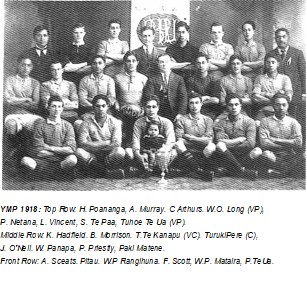
1910 had also been the year that the first NZ Maori team assembled for an Australian tour and matches in New Zealand. With the isolation of the District and so little opportunity for notice by selectors it says much for the caliber of the players that Poverty Bay provided four members of that first team: Alongside AP Kaipara were W. Burnett and Charles Ryland of YMP and Moana Paratene of another new club. YMCA. That precedence was added to in 1911 with the NZ Maori on tour in New Zealand containing five from PB, with Kaipara, Burnett and Ryland joined by YMP’s W. Kouka and Tokomaru Bay’s Erekana Pewhairangi.
The first peacetime season of 1919, when rugby was played on the Childers Road Reserve, saw the formation, on 1st April, of what was initially called “The Secondary Schools Old Boys Club” at a meeting of the Secondary Schools’ Old Boys Association. The first Club Captain was AJ Stock and, in its formative years boasted many of the Bay’s most prominent players, such as Wally Lang-lands and his brother, Henry, Basil Hundleby, John Mouatt, Andrew Murray, Alex McPhail and Keith Woodward.
The club was already referred to simply as “Old Boys” when, by the end of that first season it was runner-up in the senior championship, a feat it repeated in 1922 and 23. The senior championship was annexed for the first time in 1924, and again in 1925, 1927, 1928 and 1931.
1921-A Year Of Note
1921 was a year of note. This was the last season the East Coast sub-union was still administered by the Poverty Bay Union and it was a year in which the first South African team toured New Zealand. 1921 also saw visiting NSW representatives become the first Australian team to play against Poverty Bay It was a time when rugby had virtually disappeared in the other states “across the ditch.”
Despite the difficulties in assembling players for training from the wider area, PB gave the appearance of a competent team: Wally Langlands, later to be considered unlucky in missing NZ selection for the 1924-5 All Blacks and the well performed centre. Basil Hundleby were players from Old Boys, YMP’s Pare Tureia was an accomplished five-eighths who had represented the 1919 NZ Army team in Britain, Wing-forward, Pine Taiapa (Tikitiki) was a NZ Maori lock. Jack Heeney (Kaiti-City) a member of the renewed boxing brothers and the half-back JJ Mill (Tokomaru Bay Wanderers) was already considered of much promise.
In a bright, open game watched by 3-4,000, the largest crowd yet, the superior backline speed of the visitors was the telling point with a half-time lead of 11-0 that stretched to 21-8 by the end. The strong work of the home forwards had carried play to the NSW goal-line a number of times, allowing Mill to dive over on one occasion and, on another, an intercept by the elusive Tureia had resulted in a second try.
The Poverty Bay players in the forward pack of the Combined Hawkes Bay-Poverty Bay side which made the Springboks struggle hard for a 14-8 win a month later at Napier were Ed Torrie (Kaiti-City),W. Te Whata (Tokomaru Bay)and the Tom Heeney (Kaiti-City) who went on to fight Gene Tunney for the World Heavyweight Championship in 1928. Langlands, Tureia and Mill were members of the backline while Hundleby was a Reserve Later, in the 1921 match, NZ Maori 8 – Springboks 9 (racist remarks in a cable to South Africa in the aftermath of which made it one of NZ’s most controversial games) playing at halfback inside his Captain, Tureia, Jimmy Mill gave further indication of the talents that would make him one of the stars of the 1924-25 “Invincibles” with his trademark lightning breaks from the scrum.
1924 – 1926
W.J (Wally) Langlands played in the final trial before the selection of the 1924 All Blacks. That same year, under his captaincy, the Poverty Bay team had gone on a short internal tour winning two fixtures against Manawatu and Bush but meeting their match and suffering a 10-46 drubbing in the third game against the extremely strong Hawkes Bay Ranfurly Shield holders. In that game, Vic Caulton, Captain of the Gisborne High School 1st XV and “a fine attacking player with sidestep, swerve and fend,” played at centre-threequarter when Langlands went to fullback following an injury. The next year, 17 March 1925, Caulton was one of those who were instrumental in the founding of a new Junior club, Gisborne High School Old Boys – with membership confined to ex-students of Gisborne High. Led yet again by Langlands, in that year Poverty Bay lost narrowly to Auckland 6-11 but won the other three engagements including the 50 points against Bush that was to remain the Bay’s highest score for many years.
The two wins against East Coast must have been decisive when it came to the selection of the combined team to face touring NSW as Poverty Bay supplied 10 of the team that took the field. In the event the visitors prevailed 11 – 3 but the locals put up a spirited performance which put NSW under pressure for much of the game The try for the combined team came when, from a lineout win by Michael Whaitiri (YMP) the ball was fed back by future Maori All Black, Jim Leach (Tolaga Bay) and moved by halfback, Piki Smith (YMP) to put first five-eighths Langlands in at the corner.
Perhaps the most outstanding Poverty Bay performance over these years was the Bay’s historic 17-14 win over Auckland at Eden Park in 1926. It was a feat that has never been repeated. In that year, too, YMP’s Tom Dennis was selected in the NZ Maori side for a long and what must have been a testing and arduous tour encompassing France, England, Wales and British Columbia, with two matches in NZ before leaving, two games in Australia and one in Ceylon en route.
Brightest Stars In The ’20’s Firmament
Throughout the 1920s the player recognized as the best produced in the District since the days of AP Kaipara was W.J. (Wally) Langlands. He had been a founding member of the Old Boys club in 1919 and represented Poverty Bay in all its inter-provincial games from that year until 1930. He was appointed as captain of the team over the 7 years from 1924 In all of his 12 years he proved his versatility by playing 1st five-eighth, center-threequarter and fullback. With his armory of a deceptive sidestep allied to quick acceleration one observer referred to him as a player with “customary sparkle.”
After 1921 he rose to further fame, particularly at five-eighth, after his play as a member of the Combined Team versus South Africa was followed by selection for the North Island Teams of 1925 and 1928 as well as for the North Island “Minor Unions” of the latter year.
He was called into the final trial before selection of the All Blacks who went on to become designated as “The Invincibles” on their 1924-25 tour of the UK. Although not feeling well, beforehand, he took the field with the outcome that an understandable lack-luster performance left many feeling that he had been very unlucky not to have been an All Black. One who did express that opinion was the great second five-eighth Bert Cooke, who had partnered Langlands in that trial.
His last game was as captain of the Poverty Bay-East Coast-Bay of Plenty team which played the 1930 British tourists.
Writing in the programme for the 1980 Poverty Bay v. Auckland Ranfurly Shield match, the doyen of NZ Rugby Writers, TP McLean declared that had Wally Langlands lived in one of the major unions he would assuredly have worn the silver fern.
The other Poverty Bay player who signaled outstanding ability in the late 1920s and could have worn the fern was I.D.Bramwell When he donned the Bays colours in 1927 it was the fourth province he had represented. He had originally been called into the Manawatu squad as a 19 year-old in 1921, had turned out for King Country in 1924 and represented Wellington in 1926 before transferring to Gisborne.
In the North Island “Minor Unions” fixture of 1928 and the full North Island game of the same year, the combination behind the scrum was the Gisborne Old Boys duo of Langlands at five-eighth outside Ivan Bramwell at scrum-half. By scoring 2 tries and having a hand in another in that first match Bramwell was brought to the notice of NZ selectors who ensured that his clever play and breaks from the scrum continued into the next inter-island fixture as well as an invitation to the NZ trials.
When regular NZ halfback. Bill Dalley was injured on the 1928 Australian tour Ivan Bramwell, as the logical replacement, became the first Poverty Bay player to be selected for the All Blacks. However, having completed pharmacy qualifications and in the second year of running his Chemist shop as well as being newly married, he was forced to decline the invitation
The strength of the Old Boys Club in those years was reflected in the fact that, another try scorer for the North Island “Minor Unions’ in 1928 was Langlands’ and Bramwell’s club-mate, the hard-nosed Hooker, E.R. (“Vesty”) Thomas.
1930 The Visitors From Britain
In 1930 the rugby fever which gripped NZ with the visit of the British team was experienced in Poverty Bay. Since the Union’s 1927 purchase of a half-share in it, the Oval had been the District’s main rugby ground and a crowd of 8,000 converged on it to see the 15th game of the tour. There were some fine individual players in the Poverty Bay-East Coast-Bay of Plenty selection that was really a PB-EC combination as the two local Unions each provided 7 players as against a sole Opotiki-based player. Poverty Bay’s 3 leading players were W.J. Langlands (captain) at five-eighth, All Black trialist, E.R. (“Vesty”) Thomas at Hooker and NZ XV Lock, A.G. McPhail, partnered by future Coast All Black, Tori Reid. At fullback, the famed George Nepia was in his last season for the All Blacks.
Although, in the opening stanza, a highlight was an attempted dropped goal from Nepia on half-way that hit the upright and veered away, the Combined side were so plagued by early nervousness that they were overwhelmed. The superior pace of the visiting backs contributed to 3 Tries, 2 conversions and 3 penalties so the half-time score stood at 22-0
There was a complete reversal after that. The local pack, with wing-forward, Keith Walters (Ormond Rovers) in the van, penned the British forwards in their own half for the greater part of the second spell and came away with 3 tries to their opponent’s one. A representative from each of ^e 3 Unions claimed those tries with one each from BoP wing, G Farmer, Coast’s Reid and PB’s “Vesy” Thomas. In the end, British polish had prevailed 25-11 but the major difference in the score was tie 13 points from the boot of the touring captain, FD Prentice. However, the locals could take great pride in the fact that they were the first side to score more than 2 Tries against the tourists to that point in the tour.
1931 -1937 The Effects Of The Depression Years
Difficulties in maintaining the game at club level with the onset and continuation of the Depression were reflected in that the Public Works Dept and Ormond Rovers Clubs ceased to exist after 1931 and throughout the years following 1932 the mainstays of the senior competition were Old Boys, YMP, Gisborne HSOB, now advanced to the senior ranks, and the Gisborne Celtic Club which had been established in the competition since its founding in 1924. That this latter club was arguably the strongest of the clubs during these years is evidenced by the fact that between 1933 and 1935 Gisborne Celtic annexed the senior competition for 3 successive seasons. Marist Old Boys had begun as a club in the 3rd Grade in 1933 and only advanced to senior status after 1934.
However, there were some other new affiliations to the Union: In the junior ranks an Unemployed Club was formed by young men out of work and, after 1933 there was the appearance of a new sub-union involving clubs from Hangaroa, Waerenga-a-kuri, Tiniro-to. Tahunga-Tahora and Te Reinga. To counter-balance that the Waikohu sub-union had so much difficulty in recruiting players that, for the 1935 season, they had to overcome the situation by forming a side from those available to play in the “Town’ competition as the “Waikohu” club. With the easing of the Depression after 1938, the Hangaroa sub-union was unable to continue but otherwise normality returned to the club scene
For part of 1937, a further restriction imposed on rugby, particularly in the lower grades, had been a Health Dept. veto on large numbers of people congregating in one place because of a poliomyelitis epidemic.
Regardless, the Poverty Bay Representative team continued to play matches throughout the period. One bright light was the 14-13 narrow win over an Auckland XV in Gisborne during 1934, particularly satisfying in view of the fact that, 3 days later, 13 of the team who had played against Poverty Bay were in the Auckland side which lifted the Ranfurly Shield from previously dominant Hawkes Bay.
1937 v. The Best Team That Ever Left NZ
Many of those who saw 1937 Springboks, in action regarded the side as the finest team they ever saw. Indeed, that side has sometimes been referred to as “the best team ever to have left NZ.” Philip Nels ‘Boks met with a Poverty Bay-East Coast- Bay of Plenty selection, at the Oval, in Gisborne on 15 September with 8 of the Combined team coming from Poverty Bay.
There were many bright patches in the match but, despite resolute defence by the combined side the visitors won easily, 33-0, 7 tries and 6 conversions. One of the undoubted stars of the game, though he did not appear on the scoreboard, was the centre, Louis Babrow and the other was the effervescent five-eighth Toby Harris with 3 of the tries to his name
Both teams were captained by lock forwards who stood at one inch over 6 feet but there the physical comparison ended for whereas the international veteran, Nel was 34 years of age and weighed in at over 15 stone the Combined side’s skipper, Fred McAneney was 10 years younger and, at 12st 10lbs (76.2kg s), was the lightest of the home pack. His reputation of being the fittest man on the field and an honest toiler had helped the Celtic Club claim the Poverty Bay senior championship on 4 of the 5 years since he had joined them from Waikohu in 1934. His hard graft in the tight earned Nel’s later praise.
Fittingly, in view of their future achievements, the 2 wingers of the Combined team were the standout locals on the day Fred’s brother and fellow Celtic player, Alex, at 19 and the “baby” of the side, big and strong and with pace, made several notable dashes without reward but signaled the form that would bring him selection for the North Island in 1939. He must have been on the radar for the 1940 South African tour which went by the board with the outbreak of war but he moved on to demonstrate his speed and thrust in scoring 2 tries as part of the NZEF backline that defeated the Rest of the Combined Services in Egypt, 1942. Sadly, aged 24, he was killed at El Alamein.
On the other wing, Eric Grant refused to be outpaced by his opposite. He had played for HSOB in 1933-34 before going off to Teacher-training in Auckland where he toured Japan as a member of the NZ Universities Team before returning to Gisborne and HSOB During the war. while stationed with the Air Force in the UK he played for NZ Services and also for Scotland in the internationals of 1942- 1945.


